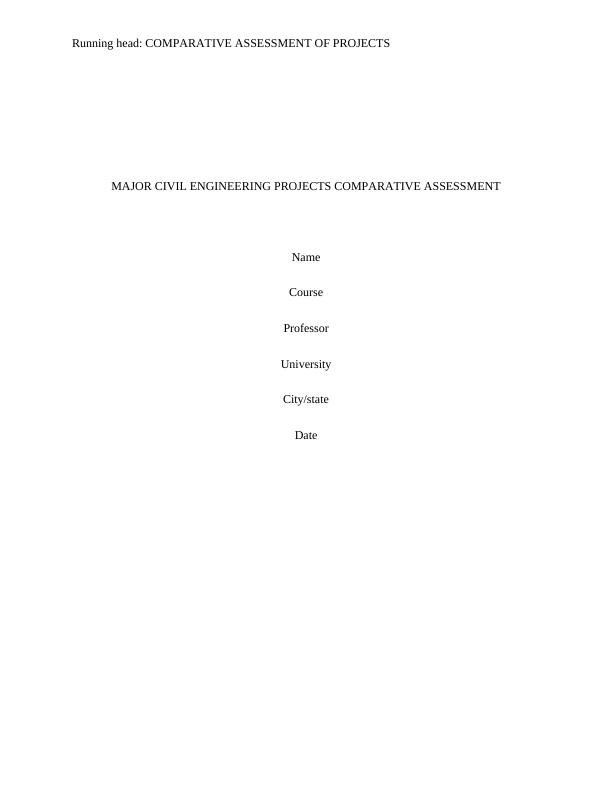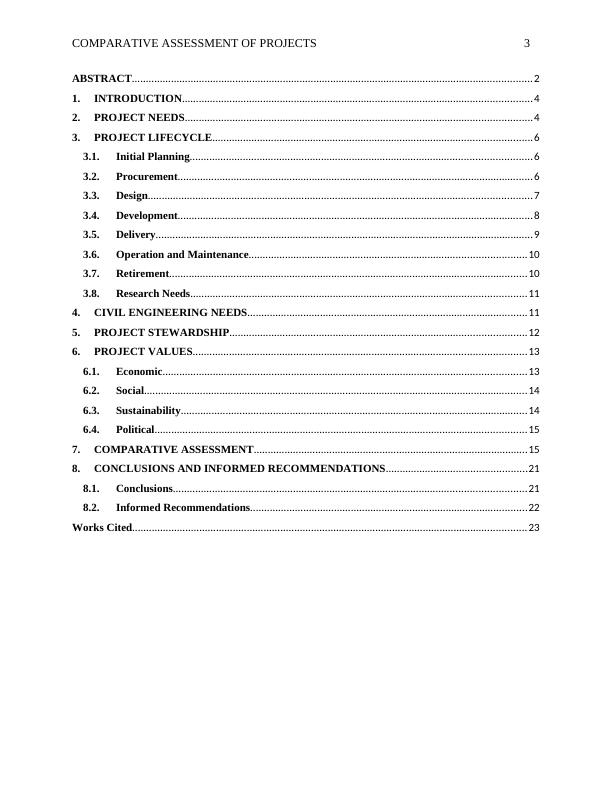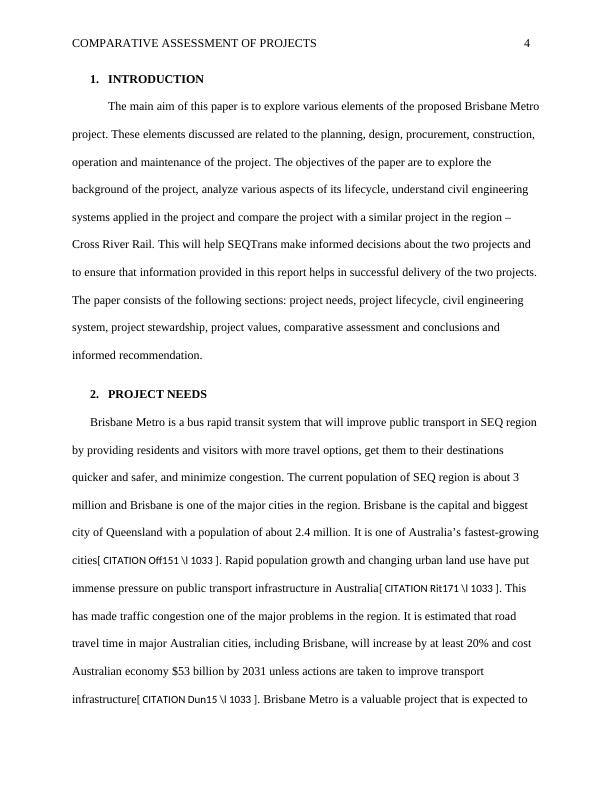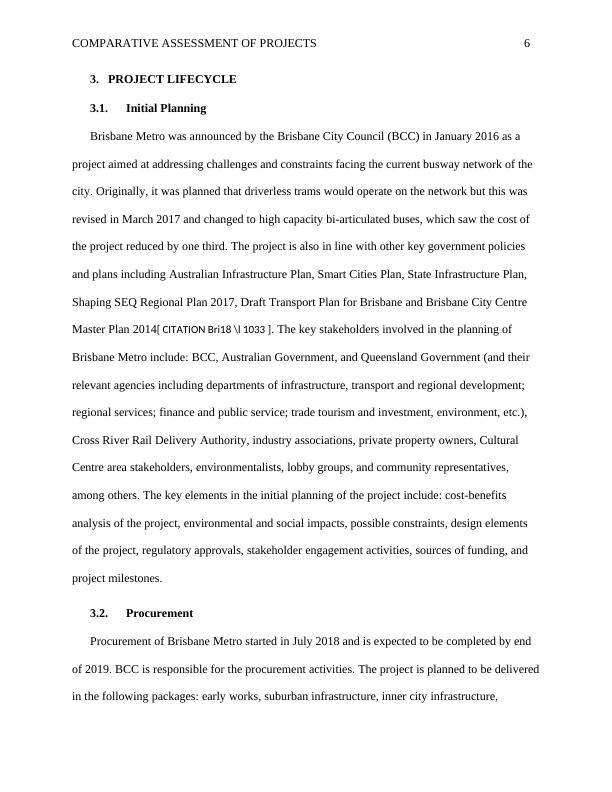Comparative Assessment of Major Civil Engineering Projects
Added on 2023-06-03
24 Pages7494 Words288 Views
Running head: COMPARATIVE ASSESSMENT OF PROJECTS
MAJOR CIVIL ENGINEERING PROJECTS COMPARATIVE ASSESSMENT
Name
Course
Professor
University
City/state
Date
MAJOR CIVIL ENGINEERING PROJECTS COMPARATIVE ASSESSMENT
Name
Course
Professor
University
City/state
Date

COMPARATIVE ASSESSMENT OF PROJECTS 2
ABSTRACT
The main purpose of this report is to explore the Brisbane Metro project, which is a mega
infrastructure project that is anticipated to transform public transportation in South East
Queensland (SEQ). The project is estimated to cost $944 million and is being undertaken by the
Brisbane City Council (BCC). The report also compares this project with a similar one – the
Cross River Rail project. The assessment has been done by evaluating a wide range of aspects
about the project including: project needs, project lifecycle, civil engineering system, project
stewardship and project values. Brisbane Metro project will have numerous economic, social,
environmental and political impacts in SEQ region. The region is growing rapidly in terms of
demographics and economy and therefore information in this report will help SEQTrans, a
government consortium, to make informed decisions about how to implement the projects
successfully. The two projects have been planned and designed to complement each other and
therefore should be supported by all levels of governments to ensure successful delivery.
Table of Contents
ABSTRACT
The main purpose of this report is to explore the Brisbane Metro project, which is a mega
infrastructure project that is anticipated to transform public transportation in South East
Queensland (SEQ). The project is estimated to cost $944 million and is being undertaken by the
Brisbane City Council (BCC). The report also compares this project with a similar one – the
Cross River Rail project. The assessment has been done by evaluating a wide range of aspects
about the project including: project needs, project lifecycle, civil engineering system, project
stewardship and project values. Brisbane Metro project will have numerous economic, social,
environmental and political impacts in SEQ region. The region is growing rapidly in terms of
demographics and economy and therefore information in this report will help SEQTrans, a
government consortium, to make informed decisions about how to implement the projects
successfully. The two projects have been planned and designed to complement each other and
therefore should be supported by all levels of governments to ensure successful delivery.
Table of Contents

COMPARATIVE ASSESSMENT OF PROJECTS 3
ABSTRACT...............................................................................................................................................2
1. INTRODUCTION.............................................................................................................................4
2. PROJECT NEEDS............................................................................................................................4
3. PROJECT LIFECYCLE..................................................................................................................6
3.1. Initial Planning..........................................................................................................................6
3.2. Procurement...............................................................................................................................6
3.3. Design.........................................................................................................................................7
3.4. Development...............................................................................................................................8
3.5. Delivery.......................................................................................................................................9
3.6. Operation and Maintenance...................................................................................................10
3.7. Retirement................................................................................................................................10
3.8. Research Needs........................................................................................................................11
4. CIVIL ENGINEERING NEEDS....................................................................................................11
5. PROJECT STEWARDSHIP..........................................................................................................12
6. PROJECT VALUES.......................................................................................................................13
6.1. Economic..................................................................................................................................13
6.2. Social.........................................................................................................................................14
6.3. Sustainability............................................................................................................................14
6.4. Political.....................................................................................................................................15
7. COMPARATIVE ASSESSMENT..................................................................................................15
8. CONCLUSIONS AND INFORMED RECOMMENDATIONS..................................................21
8.1. Conclusions..............................................................................................................................21
8.2. Informed Recommendations...................................................................................................22
Works Cited.............................................................................................................................................23
ABSTRACT...............................................................................................................................................2
1. INTRODUCTION.............................................................................................................................4
2. PROJECT NEEDS............................................................................................................................4
3. PROJECT LIFECYCLE..................................................................................................................6
3.1. Initial Planning..........................................................................................................................6
3.2. Procurement...............................................................................................................................6
3.3. Design.........................................................................................................................................7
3.4. Development...............................................................................................................................8
3.5. Delivery.......................................................................................................................................9
3.6. Operation and Maintenance...................................................................................................10
3.7. Retirement................................................................................................................................10
3.8. Research Needs........................................................................................................................11
4. CIVIL ENGINEERING NEEDS....................................................................................................11
5. PROJECT STEWARDSHIP..........................................................................................................12
6. PROJECT VALUES.......................................................................................................................13
6.1. Economic..................................................................................................................................13
6.2. Social.........................................................................................................................................14
6.3. Sustainability............................................................................................................................14
6.4. Political.....................................................................................................................................15
7. COMPARATIVE ASSESSMENT..................................................................................................15
8. CONCLUSIONS AND INFORMED RECOMMENDATIONS..................................................21
8.1. Conclusions..............................................................................................................................21
8.2. Informed Recommendations...................................................................................................22
Works Cited.............................................................................................................................................23

COMPARATIVE ASSESSMENT OF PROJECTS 4
1. INTRODUCTION
The main aim of this paper is to explore various elements of the proposed Brisbane Metro
project. These elements discussed are related to the planning, design, procurement, construction,
operation and maintenance of the project. The objectives of the paper are to explore the
background of the project, analyze various aspects of its lifecycle, understand civil engineering
systems applied in the project and compare the project with a similar project in the region –
Cross River Rail. This will help SEQTrans make informed decisions about the two projects and
to ensure that information provided in this report helps in successful delivery of the two projects.
The paper consists of the following sections: project needs, project lifecycle, civil engineering
system, project stewardship, project values, comparative assessment and conclusions and
informed recommendation.
2. PROJECT NEEDS
Brisbane Metro is a bus rapid transit system that will improve public transport in SEQ region
by providing residents and visitors with more travel options, get them to their destinations
quicker and safer, and minimize congestion. The current population of SEQ region is about 3
million and Brisbane is one of the major cities in the region. Brisbane is the capital and biggest
city of Queensland with a population of about 2.4 million. It is one of Australia’s fastest-growing
cities (Office of the Auditor General, 2015). Rapid population growth and changing urban land
use have put immense pressure on public transport infrastructure in Australia (Ritchie, 2017).
This has made traffic congestion one of the major problems in the region. It is estimated that
road travel time in major Australian cities, including Brisbane, will increase by at least 20% and
cost Australian economy $53 billion by 2031 unless actions are taken to improve transport
infrastructure (Dunckley & Saulwick, 2015). Brisbane Metro is a valuable project that is
1. INTRODUCTION
The main aim of this paper is to explore various elements of the proposed Brisbane Metro
project. These elements discussed are related to the planning, design, procurement, construction,
operation and maintenance of the project. The objectives of the paper are to explore the
background of the project, analyze various aspects of its lifecycle, understand civil engineering
systems applied in the project and compare the project with a similar project in the region –
Cross River Rail. This will help SEQTrans make informed decisions about the two projects and
to ensure that information provided in this report helps in successful delivery of the two projects.
The paper consists of the following sections: project needs, project lifecycle, civil engineering
system, project stewardship, project values, comparative assessment and conclusions and
informed recommendation.
2. PROJECT NEEDS
Brisbane Metro is a bus rapid transit system that will improve public transport in SEQ region
by providing residents and visitors with more travel options, get them to their destinations
quicker and safer, and minimize congestion. The current population of SEQ region is about 3
million and Brisbane is one of the major cities in the region. Brisbane is the capital and biggest
city of Queensland with a population of about 2.4 million. It is one of Australia’s fastest-growing
cities (Office of the Auditor General, 2015). Rapid population growth and changing urban land
use have put immense pressure on public transport infrastructure in Australia (Ritchie, 2017).
This has made traffic congestion one of the major problems in the region. It is estimated that
road travel time in major Australian cities, including Brisbane, will increase by at least 20% and
cost Australian economy $53 billion by 2031 unless actions are taken to improve transport
infrastructure (Dunckley & Saulwick, 2015). Brisbane Metro is a valuable project that is

COMPARATIVE ASSESSMENT OF PROJECTS 5
expected to offer a long-tern solution to traffic congestion problem in SEQ region. The project
will improve accessibility and connectivity, improve amenity and efficiency, increase transport
mode share, improve capacity, increase reliability, improve travel time, create regional jobs, and
support economic growth. The Brisbane Metro network is as shown in Figure 1 below.
Figure 1: Brisbane Metro network
expected to offer a long-tern solution to traffic congestion problem in SEQ region. The project
will improve accessibility and connectivity, improve amenity and efficiency, increase transport
mode share, improve capacity, increase reliability, improve travel time, create regional jobs, and
support economic growth. The Brisbane Metro network is as shown in Figure 1 below.
Figure 1: Brisbane Metro network

COMPARATIVE ASSESSMENT OF PROJECTS 6
3. PROJECT LIFECYCLE
3.1. Initial Planning
Brisbane Metro was announced by the Brisbane City Council (BCC) in January 2016 as a
project aimed at addressing challenges and constraints facing the current busway network of the
city. Originally, it was planned that driverless trams would operate on the network but this was
revised in March 2017 and changed to high capacity bi-articulated buses, which saw the cost of
the project reduced by one third. The project is also in line with other key government policies
and plans including Australian Infrastructure Plan, Smart Cities Plan, State Infrastructure Plan,
Shaping SEQ Regional Plan 2017, Draft Transport Plan for Brisbane and Brisbane City Centre
Master Plan 2014 (Brisbane City Council, 2018). The key stakeholders involved in the planning
of Brisbane Metro include: BCC, Australian Government, and Queensland Government (and
their relevant agencies including departments of infrastructure, transport and regional
development; regional services; finance and public service; trade tourism and investment,
environment, etc.), Cross River Rail Delivery Authority, industry associations, private property
owners, Cultural Centre area stakeholders, environmentalists, lobby groups, and community
representatives, among others. The key elements in the initial planning of the project include:
cost-benefits analysis of the project, environmental and social impacts, possible constraints,
design elements of the project, regulatory approvals, stakeholder engagement activities, sources
of funding, and project milestones.
3.2. Procurement
Procurement of Brisbane Metro started in July 2018 and is expected to be completed by end
of 2019. BCC is responsible for the procurement activities. The project is planned to be delivered
in the following packages: early works, suburban infrastructure, inner city infrastructure,
3. PROJECT LIFECYCLE
3.1. Initial Planning
Brisbane Metro was announced by the Brisbane City Council (BCC) in January 2016 as a
project aimed at addressing challenges and constraints facing the current busway network of the
city. Originally, it was planned that driverless trams would operate on the network but this was
revised in March 2017 and changed to high capacity bi-articulated buses, which saw the cost of
the project reduced by one third. The project is also in line with other key government policies
and plans including Australian Infrastructure Plan, Smart Cities Plan, State Infrastructure Plan,
Shaping SEQ Regional Plan 2017, Draft Transport Plan for Brisbane and Brisbane City Centre
Master Plan 2014 (Brisbane City Council, 2018). The key stakeholders involved in the planning
of Brisbane Metro include: BCC, Australian Government, and Queensland Government (and
their relevant agencies including departments of infrastructure, transport and regional
development; regional services; finance and public service; trade tourism and investment,
environment, etc.), Cross River Rail Delivery Authority, industry associations, private property
owners, Cultural Centre area stakeholders, environmentalists, lobby groups, and community
representatives, among others. The key elements in the initial planning of the project include:
cost-benefits analysis of the project, environmental and social impacts, possible constraints,
design elements of the project, regulatory approvals, stakeholder engagement activities, sources
of funding, and project milestones.
3.2. Procurement
Procurement of Brisbane Metro started in July 2018 and is expected to be completed by end
of 2019. BCC is responsible for the procurement activities. The project is planned to be delivered
in the following packages: early works, suburban infrastructure, inner city infrastructure,

End of preview
Want to access all the pages? Upload your documents or become a member.
Related Documents
Comparative Assessment of Major Civil Engineering Projectslg...
|25
|7741
|400
EGB123: Civil Engineering Systemslg...
|2
|413
|188
EGB123 Civil Engineering Systemslg...
|21
|4095
|91
Report on Carmichael Coal Minelg...
|13
|3408
|158
BYOD Policy Threats and Security Strategies for Cybersecuritylg...
|11
|2820
|426
